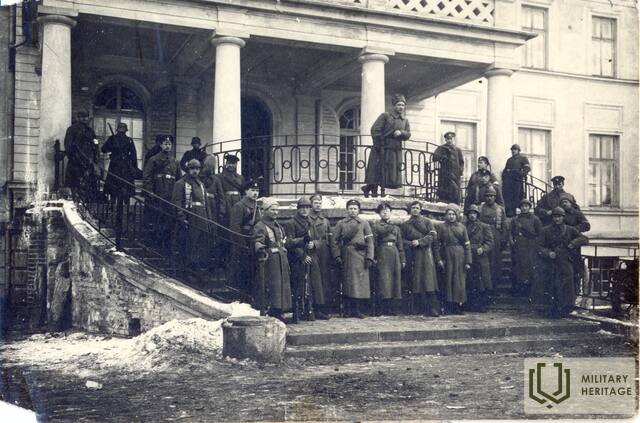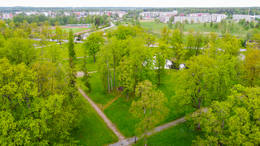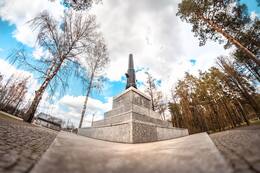Regiment
Independence of the Baltic States, I World War I, I Wars of Independence
A regiment (Latvian: pulks, German: Regiment) is a military unit in the European military tradition, including the Latvian Army.
It was the largest unit of a single weapon class (foot soldiers, mounted infantry or artillery) under the command of a colonel. For tactical tasks, regiments divided into battalions and companies for foot soldiers, division and batteries for artillery, and divisions and squadrons for mounted infantry.
Related timeline
Related objects
Latvian Military Aviation Airport
Located in the territory of Vecgulbene Manor - in the historical center.
In the interwar period, Gulbene was home to a Latvian army garrison, where the 7th Sigulda Infantry Regiment battalion was stationed. In the mid-1930s, the creation of a military aviation base began, because for the successful operation of military aviation, an extensive network of airfields must be ensured even in peacetime. Airfields are especially important in places where important railway and road junctions have been established. On November 11, 1935, construction of a military airfield began here. In 1937, a newly formed Aviation Regiment unit was stationed in Gulbene, which became the 6th reconnaissance squadron of the Latgale Division, increasing the number of army units near the eastern border of Latvia.
The Orangery building is visible.
Livani Liberation Monument
The monument is located at the intersection of Fabrikas and Stacijas streets, where it was unveiled on June 9, 1935 by General Rūdolfs Bangerskis, honoring the memory of the soldiers who fell in the battles for the liberation of Līvāni in 1919.
Its main element is a 15-ton, vertically placed cannon barrel. In 1958, the Soviet government dismantled the symbol of freedom in Līvāni, cutting the cannon barrel into scrap metal. The residents preserved the cannonballs throughout the Soviet years, and they returned to their previous location after half a century. The idea of restoring the monument was alive among the people all these years. The Līvāni County Council, together with the residents, actively worked on the restoration of the monument. Donations were collected from the people, and on October 3, 2004, the restored Līvāni Liberation Monument was unveiled in its historical place in the city park.
Inscription on the monument: “Soldiers of the Jelgava Infantry Regiment who fell for Latvia near Līvāni and the liberation of the surrounding area in 1919. Soldiers of the former Northern Latvian Partisan Regiment.”
The names of soldiers and partisans follow.
Memorial plaques for the cavaliers of the Lāčplēsis War Order in Līvāni district have been installed nearby.
The author of the monument's design was architect Pāvils Dreimanis.
October 3–5, 1919. Battle of Līvāni
On October 3, 1919, the Bolsheviks received a strong blow on the front near Līvāni. Units of the 3rd Jelgava and 4th Valmiera Infantry Regiments, as well as units of the Latvian German Landeswehr (former Landeswehr), participated in the attack on Līvāni. With artillery support, units of the 3rd Jelgava Infantry Regiment moved across the Daugava. After the successful move, the battle for Līvāni began, which lasted all day long. At around 17:30, Līvāni station was captured, and an hour later the bridges over the Dubna River were crossed. The combined forces managed to drive the Bolsheviks out of Līvāni, and by 19:00 the city was completely liberated. On October 5, 1919, the Bolsheviks tried to regain Līvāni by attacking the new positions of the 3rd Jelgava and 4th Valmiera Infantry Regiments. The Latvians held the occupied positions with difficulty. This was the first serious and successful attack on the Eastern Front between July and October 1919.
While at the Līvāni Liberation Monument, you can scan the QR code and listen to an audio story about the history of the monument. The story is also available on the IziTravel platform HERE . The story is available in Latvian and English.
Related stories
7. Formation of the Sigulda Infantry Regiment
On June 20, 1919, the 7th Sigulda Infantry Regiment began to be formed in Naukšēni Manor, near Rūjiena, according to the order of the commander of the North Latvian Brigade, Colonel Jorģis Zemitāns. Initially, a small combat group consisting of 22 officers and 1,580 soldiers was formed from the reserve battalion of the North Latvian Brigade, which, in honor of its first commander Oskars Danker, was named the Danker Division. A few days later, the division was included in the 2nd Battalion of the 3rd Jelgava Regiment, and on August 23, with the addition of a company, it was included in the 7th Sigulda Infantry Regiment.
Liberation of Northern Latgale from the Bolsheviks
On December 1, 1918, the Red Army units, based on the Red Riflemen units, invaded the territory of Latvia. In order to protect their homes, families, native region and escape from terror, the men of the Balvi area took up arms and went into the forests, the formation of the first “green” groups began. In the spring of 1919, when mobilization was announced, many men of the Balvi area found fighting in the Soviet Latvian Army unacceptable and joined the “green” groups. The Balvi, Silakrogs, Rugāji, Teteru-Dūrupe and Liepna groups were formed. The activities of the “green” groups in the Balvi area became more active in March 1919.









